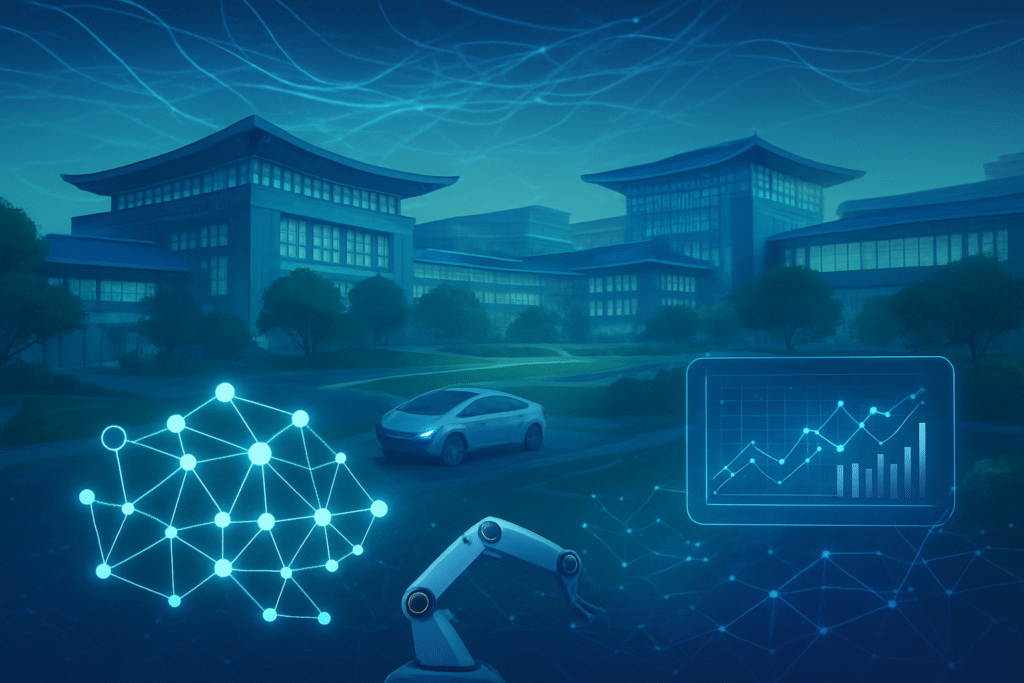
Beijing, China – Tsinghua University, a venerable institution with a rich history in science and engineering education, has emerged as a formidable force in the global artificial intelligence (AI) boom, notably surpassing renowned American universities like Harvard and the Massachusetts Institute of Technology (MIT) in the number of AI patents. This achievement underscores China's aggressive investment and rapid ascent in cutting-edge technology, with Tsinghua at the forefront of this transformative era.
Established in 1911, Tsinghua University has a long-standing legacy of academic excellence and a pivotal role in China's scientific and technological development. Historically, Tsinghua scholars have made pioneering contributions across various fields, solidifying its foundation in technical disciplines. Today, Tsinghua is not merely a historical pillar but a modern-day titan in AI research, consistently ranking at the top in global computer science and AI rankings. Its prolific patent output, exceeding that of institutions like Harvard and MIT, solidifies its position as a leading innovation engine in China's booming AI landscape.
Technical Prowess: From Photonic Chips to Cumulative Reasoning
Tsinghua University's AI advancements span a wide array of fields, demonstrating both foundational breakthroughs and practical applications. In machine learning, researchers have developed efficient gradient optimization techniques that significantly enhance the speed and accuracy of training large-scale neural networks, crucial for real-time data processing in sectors like autonomous driving and surveillance. Furthermore, in 2020, a Tsinghua team pioneered Multi-Objective Reinforcement Learning (MORL) algorithms, which are particularly effective in scenarios requiring the simultaneous balancing of multiple objectives, such as in robotics and energy management. The university has also made transformative contributions to autonomous driving through advanced perception algorithms and deep reinforcement learning, enabling self-driving cars to make rapid, data-driven decisions.
Beyond algorithms, Tsinghua has pushed the boundaries of hardware and software integration. Scientists have introduced a groundbreaking method for photonic computing called Fully Forward Mode (FFM) Training for Optical Neural Networks, along with the Taichi-II light-based chip. This offers a more energy-efficient and faster way to train large language models by conducting training processes directly on the physical system, moving beyond the energy demands and GPU dependence of traditional digital emulation. In the realm of large language models (LLMs), a research team proposed a "Cumulative Reasoning" (CR) framework to address the struggles of LLMs with complex logical inference tasks, achieving 98% precision in logical inference tasks and a 43% relative improvement in challenging Level 5 MATH problems. Another significant innovation is the "Absolute Zero Reasoner" (AZR) paradigm, a Reinforcement Learning with Verifiable Rewards (RLVR) approach that allows a single model to autonomously generate and solve tasks, maximizing its learning progress without relying on any external data, outperforming models trained with expert-curated human data in coding. The university also developed YOLOv10, an advancement in real-time object detection that introduces an End-to-End head, eliminating the need for Non-Maximum Suppression (NMS), a common post-processing step.
Tsinghua University holds a significant number of AI-related patents, contributing to China's overall lead in AI patent filings. Specific examples include patent number 12346799 for an "Optical artificial neural network intelligent chip," patent number 12450323 for an "Identity authentication method and system" co-assigned with Huawei Technologies Co., Ltd. (SHE: 002502), and patent number 12414393 for a "Micro spectrum chip based on units of different shapes." The university leads with approximately 1,200 robotics-related patents filed in the past year and 32 relevant patent applications in 3D image models. This prolific output contrasts with previous approaches by emphasizing practical applications and energy efficiency, particularly in photonic computing. Initial reactions from the AI research community acknowledge Tsinghua as a powerhouse, often referred to as China's "MIT," consistently ranking among the top global institutions. While some experts debate the quality versus quantity of China's patent filings, there's a growing recognition that China is rapidly closing any perceived quality gap through improved research standards and strong industry collaboration. Michael Wade, Director of the TONOMUS Global Center for Digital and AI Transformation, notes that China's AI strategy, exemplified by Tsinghua, is "less concerned about building the most powerful AI capabilities, and more focused on bringing AI to market with an efficiency-driven and low-cost approach."
Impact on AI Companies, Tech Giants, and Startups
Tsinghua University's rapid advancements and patent leadership have profound implications for AI companies, tech giants, and startups globally. Chinese tech giants like Huawei Technologies Co., Ltd. (SHE: 002502), Alibaba Group Holding Limited (NYSE: BABA), and Tencent Holdings Limited (HKG: 0700) stand to benefit immensely from Tsinghua's research, often through direct collaborations and the talent pipeline. The university's emphasis on practical applications means that its innovations, such as advanced autonomous driving algorithms or AI-powered diagnostic systems, can be swiftly integrated into commercial products and services, giving these companies a competitive edge in domestic and international markets. The co-assignment of patents, like the identity authentication method with Huawei, exemplifies this close synergy.
The competitive landscape for major AI labs and tech companies worldwide is undoubtedly shifting. Western tech giants, including Alphabet Inc. (NASDAQ: GOOGL) (Google), Microsoft Corporation (NASDAQ: MSFT), and Meta Platforms, Inc. (NASDAQ: META), which have traditionally dominated foundational AI research, now face a formidable challenger in Tsinghua and the broader Chinese AI ecosystem. Tsinghua's breakthroughs in energy-efficient photonic computing and advanced LLM reasoning frameworks could disrupt existing product roadmaps that rely heavily on traditional GPU-based infrastructure. Companies that can quickly adapt to or license these new computing paradigms might gain significant strategic advantages, potentially lowering operational costs for AI model training and deployment.
Furthermore, Tsinghua's research directly influences market positioning and strategic advantages. For instance, the development of ML-based traffic control systems in partnership with the Beijing Municipal Government provides a blueprint for smart city solutions that could be adopted globally, benefiting companies specializing in urban infrastructure and IoT. The proliferation of AI-powered diagnostic systems and early Alzheimer's prediction tools also opens new avenues for medical technology companies and startups, potentially disrupting traditional healthcare diagnostics. Tsinghua's focus on cultivating "AI+" interdisciplinary talents means a steady supply of highly skilled graduates, further fueling innovation and providing a critical talent pool for both established companies and emerging startups in China, fostering a vibrant domestic AI industry that can compete on a global scale.
Wider Significance: Reshaping the Global AI Landscape
Tsinghua University's ascent to global AI leadership, particularly its patent dominance, signifies a pivotal shift in the broader AI landscape and global technological trends. This development underscores China's strategic commitment to becoming a global AI superpower, a national ambition articulated as early as 2017. Tsinghua's prolific output of high-impact research and patents positions it as a key driver of this national strategy, demonstrating that China is not merely adopting but actively shaping the future of AI. This fits into a broader trend of technological decentralization, where innovation hubs are emerging beyond traditional Silicon Valley strongholds.
The impacts of Tsinghua's advancements are multifaceted. Economically, they contribute to China's technological self-sufficiency and bolster its position in the global tech supply chain. Geopolitically, this strengthens China's soft power and influence in setting international AI standards and norms. Socially, Tsinghua's applied research in areas like healthcare (e.g., AI tools for Alzheimer's prediction) and smart cities (e.g., ML-based traffic control) has the potential to significantly improve quality of life and public services. However, the rapid progress also raises potential concerns, particularly regarding data privacy, algorithmic bias, and the ethical implications of powerful AI systems, especially given China's state-backed approach to technological development.
Comparisons to previous AI milestones and breakthroughs highlight the current trajectory. While the initial waves of AI were often characterized by theoretical breakthroughs from Western institutions and companies, Tsinghua's current leadership in patent volume and application-oriented research indicates a maturation of AI development where practical implementation and commercialization are paramount. This mirrors the trajectory of other technological revolutions where early scientific discovery is followed by intense engineering and widespread adoption. The sheer volume of AI patents from China, with Tsinghua at the forefront, indicates a concerted effort to translate research into tangible intellectual property, which is crucial for long-term economic and technological dominance.
Future Developments: The Road Ahead for AI Innovation
Looking ahead, the trajectory set by Tsinghua University suggests several expected near-term and long-term developments in the AI landscape. In the near term, we can anticipate a continued surge in interdisciplinary AI research, with Tsinghua likely expanding its "AI+" programs to integrate AI across various scientific and engineering disciplines. This will lead to more specialized AI applications in fields like advanced materials, environmental science, and biotechnology. The focus on energy-efficient computing, exemplified by their photonic chips and FFM training, will likely accelerate, potentially leading to a new generation of AI hardware that significantly reduces the carbon footprint of large-scale AI models. We may also see further refinement of LLM reasoning capabilities, with frameworks like Cumulative Reasoning becoming more robust and widely adopted in complex problem-solving scenarios.
Potential applications and use cases on the horizon are vast. Tsinghua's advancements in autonomous learning with the Absolute Zero Reasoner (AZR) paradigm could pave the way for truly self-evolving AI systems capable of generating and solving novel problems without human intervention, leading to breakthroughs in scientific discovery and complex system design. In healthcare, personalized AI diagnostics and drug discovery platforms, leveraging Tsinghua's medical AI research, are expected to become more sophisticated and accessible. Smart city solutions will evolve to incorporate predictive policing, intelligent infrastructure maintenance, and hyper-personalized urban services. The development of YOLOv10 suggests continued progress in real-time object detection, which will enhance applications in surveillance, robotics, and augmented reality.
However, challenges remain. The ethical implications of increasingly autonomous and powerful AI systems will need continuous attention, particularly regarding bias, accountability, and control. Ensuring the security and robustness of AI systems against adversarial attacks will also be critical. Experts predict that the competition for AI talent and intellectual property will intensify globally, with institutions like Tsinghua playing a central role in attracting and nurturing top researchers. The ongoing "patent volume versus quality" debate will likely evolve into a focus on the real-world impact and commercial viability of these patents. What experts predict will happen next is a continued convergence of hardware and software innovation, driven by the need for more efficient and intelligent AI, with Tsinghua University firmly positioned at the vanguard of this evolution.
Comprehensive Wrap-up: A New Epoch in AI Leadership
In summary, Tsinghua University's emergence as a global leader in AI patents and research marks a significant inflection point in the history of artificial intelligence. Key takeaways include its unprecedented patent output, surpassing venerable Western institutions; its strategic focus on practical, application-oriented research across diverse fields from autonomous driving to healthcare; and its pioneering work in novel computing paradigms like photonic AI and advanced reasoning frameworks for large language models. This development underscores China's deliberate and successful strategy to become a dominant force in the global AI landscape, driven by sustained investment and a robust academic-industrial ecosystem.
The significance of this development in AI history cannot be overstated. It represents a shift from a predominantly Western-centric AI innovation model to a more multipolar one, with institutions in Asia, particularly Tsinghua, taking a leading role. This isn't merely about numerical superiority in patents but about the quality and strategic direction of research that promises to deliver tangible societal and economic benefits. The emphasis on energy efficiency, autonomous learning, and robust reasoning capabilities points towards a future where AI is not only powerful but also sustainable and reliable.
Final thoughts on the long-term impact suggest a future where global technological leadership will be increasingly contested, with Tsinghua University serving as a powerful symbol of China's AI ambitions. The implications for international collaboration, intellectual property sharing, and the global AI talent pool will be profound. What to watch for in the coming weeks and months includes further announcements of collaborative projects between Tsinghua and major tech companies, the commercialization of its patented technologies, and how other global AI powerhouses respond to this new competitive landscape. The race for AI supremacy is far from over, but Tsinghua University has unequivocally positioned itself as a frontrunner in shaping its future.
This content is intended for informational purposes only and represents analysis of current AI developments.
TokenRing AI delivers enterprise-grade solutions for multi-agent AI workflow orchestration, AI-powered development tools, and seamless remote collaboration platforms.
For more information, visit https://www.tokenring.ai/.






